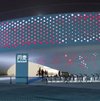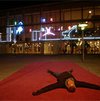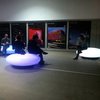In the field of urban computer-based interaction, media architecture is an umbrella term for installations in which displays are integrated into architectural structures. Using media facades as a subcategory of urban computing, CAVI’s research focus revolves around coming to grips with sense-making and social interaction as parts of identifying key characteristics of interactions with media facades in an urban setting. Moreover, we address the specific challenges of designing media architecture. Our approach strongly relies on design research-through-design, by conducting real-life design and interventions, where we have taken advantage of our engagement in specific design practices to explore aspects of urban computing. Recent cases includes Aarhus by Light, The Danish Pavilion at EXPO 2010, and Aarhus City Bug Report.
Plant a Light is a media facade situated on the iconic Tropical Dome of Aarhus Botanical Gardens. The interactive installation is a tribute to life in all its forms, and invites people to plant a light on the Dome using a glowing pillar.

Climate on the Wall is a large-scale media facade that used people’s movements to generate climate statements. During the climate conference Beyond Kyoto, citizens of Aarhus could express their commitment to get involved by creating sentences on a wall.

The Danish pavilion balanced digital art, urban design, and architecture. The enormous media facade attracted visitors, and reflected the human activity inside the construction, where people were able to view the Little Mermaid while walking or bicycling on the internal paths.

As a large-scale, interactive media facade, Aarhus by Light staged the encounter between the citizens of Aarhus and the Concert Hall, and facilitated new public behavior through the blend of architecture and digital media.

A dynamically transparent window responds to the movements of people passing by. Passers-by are tracked by a camera, and the data is processed by a system that controls custom-built, interactive windows in a facade.

The Media Architecture Biennale 2012 in Aarhus, Denmark, brought together people from around the world who were interested in discussing and outlining media architecture of the future.